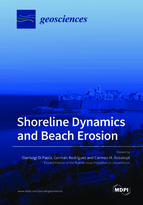Shoreline Dynamics and Beach Erosion
A special issue of Geosciences (ISSN 2076-3263).
Deadline for manuscript submissions: closed (31 May 2021) | Viewed by 38660
Special Issue Editors
Interests: coastal Geomorphology; coastal evolution; beach erosion; beach monitoring; GIS analysis; coastal risk assessment
Special Issues, Collections and Topics in MDPI journals
Interests: coastal hydrodynamics; wind and wave climate; environmental data analysis
Special Issues, Collections and Topics in MDPI journals
Interests: coastal geomorphology; cartography; historical shoreline change; short-mid term shoreline evolution; drivers of beach erosion
Special Issues, Collections and Topics in MDPI journals
Special Issue Information
Dear Colleagues,
Coasts are highly dynamic and geomorphologic complex systems with fragile balance that are now under increasing threat from climate change and anthropogenic activities that impact the coastal systems directly or indirectly. Among the major adverse impacts that can result, coastal erosion represents one of the most pressing global environmental issues, especially where it concerns flat and low-lying coastal areas that appear particularly susceptible to beach erosion and related further shoreline retreat.
In this Special Issue, we expect to collect a set of contributions providing new experimental results and methodological approaches on “shoreline dynamics” and “beach erosion”, general themes that leave ample room for in-depth analyses of various types. In fact, based on the specific purposes and geographic/climate context, the investigation of a coastal system can lead to face a number of questions and objectives. Therefore, we would like to invite you to submit articles about your research or case studies, regarding the following topics:
- beach characterization and related suitable approaches/methods;
- reconstruction of shoreline changes, recent trends and future scenarios;
- hydrometeorological extreme events and their impact on coastal morphology;
- assessment of causal factors of coastal erosion (from climate to anthropogenic drivers);
- beach erosion vs anthropization and defences of the coast;
- geological, physical and engineering-based approaches for beach erosion remediation and coastal risk assessment.
Besides studies based on classical geomorphological methods and analyses, contributions that include the use of modern technologies (such as GPS, Drones, Digital photogrammetry, etc.) and GIS analysis are particularly welcome.
Dr. Gianluigi Di Paola
Prof. Germán Rodríguez
Prof. Carmen M. Rosskopf
Guest Editors
Manuscript Submission Information
Manuscripts should be submitted online at www.mdpi.com by registering and logging in to this website. Once you are registered, click here to go to the submission form. Manuscripts can be submitted until the deadline. All submissions that pass pre-check are peer-reviewed. Accepted papers will be published continuously in the journal (as soon as accepted) and will be listed together on the special issue website. Research articles, review articles as well as short communications are invited. For planned papers, a title and short abstract (about 100 words) can be sent to the Editorial Office for announcement on this website.
Submitted manuscripts should not have been published previously, nor be under consideration for publication elsewhere (except conference proceedings papers). All manuscripts are thoroughly refereed through a single-blind peer-review process. A guide for authors and other relevant information for submission of manuscripts is available on the Instructions for Authors page. Geosciences is an international peer-reviewed open access monthly journal published by MDPI.
Please visit the Instructions for Authors page before submitting a manuscript. The Article Processing Charge (APC) for publication in this open access journal is 1800 CHF (Swiss Francs). Submitted papers should be well formatted and use good English. Authors may use MDPI's English editing service prior to publication or during author revisions.
Keywords
- Morpho-sedimentological characterization
- Coastal system analysis and modeling
- Hydro-meteorological extremes
- Sea level rise
- Coastal hydrodynamics
- Beach erosion drivers
- Coastal susceptibility and risk
- Coastal dune and beach management
- Coastline defense and anthropization.







